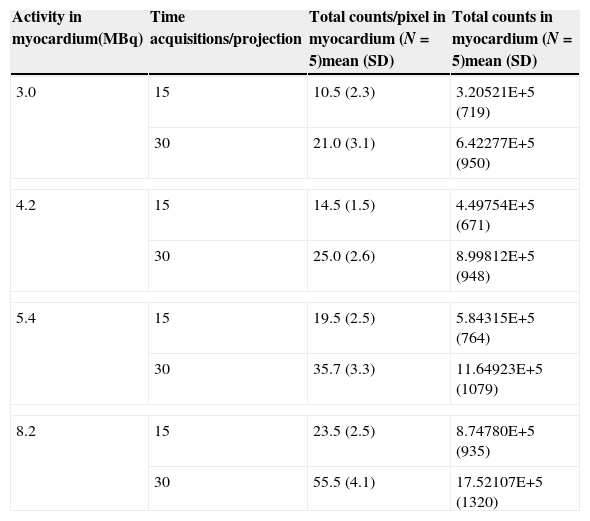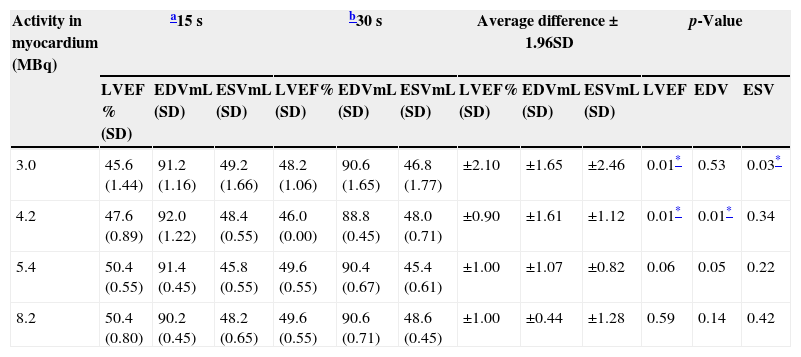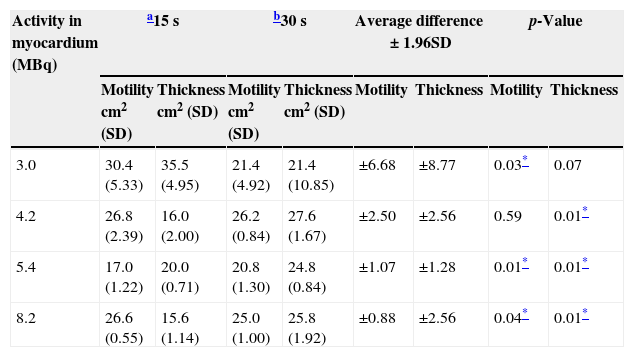Myocardial perfusion gated-single photon emission computed tomography (gated-SPECT) imaging is used for the combined evaluation of myocardial perfusion and left ventricular (LV) function. The aim of this study is to analyze the influence of counts/pixel and concomitantly the total counts in the myocardium for the calculation of myocardial functional parameters.
Material and methodsGated-SPECT studies were performed using a Monte Carlo GATE simulation package and the NCAT phantom.
The simulations of these studies use the radiopharmaceutical 99mTc-labeled tracers (250, 350, 450 and 680MBq) for standard patient types, effectively corresponding to the following activities of myocardium: 3, 4.2, 5.4–8.2MBq. All studies were simulated using 15 and 30s/projection.
The simulated data were reconstructed and processed by quantitative-gated-SPECT software, and the analysis of functional parameters in gated-SPECT images was done by using Bland–Altman test and Mann–Whitney–Wilcoxon test.
ResultsIn studies simulated using different times (15 and 30s/projection), it was noted that for the activities for full body: 250 and 350MBq, there were statistically significant differences in parameters Motility and Thickness. For the left ventricular ejection fraction (LVEF), end-systolic volume (ESV) it was only for 250MBq, and 350MBq in the end-diastolic volume (EDV), while the simulated studies with 450 and 680MBq showed no statistically significant differences for global functional parameters: LVEF, EDV and ESV.
ConclusionThe number of counts/pixel and, concomitantly, the total counts per simulation do not significantly interfere with the determination of gated-SPECT functional parameters, when using the administered average activity of 450MBq, corresponding to the 5.4MBq of the myocardium, for standard patient types.
La gammagrafía de perfusión miocárdica sincronizada con el eletrocardiograma (Gated-SPECT) permite la evaluación de la perfusión miocárdica y la función ventricular izquierda. El objetivo de este estudio fue analizar la influencia de las cuentas/pixel y, las cuentas totales en miocardio en la determinación de los parámetros funcionales.
Material y métodosHemos simulado estudios Gated-SPECT, por el método Monte Carlo GATE y el uso de fantoma NCAT.
Las simulaciones de estos estudios han considerado un paciente estándar utilizando un radiofármaco marcado con 99mTc, con diferentes actividades (250, 350, 450 y 680MBq) correspondientes a las siguientes actividades en miocardio: 3; 4,2; 5,4 a 8,2MBq. Se simularon todos los estudios con un tiempo de 15 y 30seg/proyección. Los datos simulados fueron reconstruidos, procesados y cuantificados por el software Quantitative-Gated-SPECT. El análisis de la influencia de las cuentas en los parámetros funcionales se llevó a cabo utilizando la prueba de Bland-Altman y Mann-Whitney-Wilcoxon.
ResultadosEn los estudios simulados con diferentes tiempos (15 y 30seg/proyección), se encontró que para las actividades del cuerpo entero 250 y 350MBq hubo diferencias estadísticamente significativas en los parámetros de motilidad y espesor; para la FEVI, VTS solo para 250MBq, y VTD solo para 350MBq. En los estudios simulados con 450 y 680MBq no se encontraron diferencias estadísticamente significativas para los parámetros funcionales globales: FEVI, VTD y VTS.
ConclusiónPor simulación en un paciente estándar, el número de cuentas/píxel y, de forma concomitante, las cuentas totales no interfiere significativamente en la determinación de los parámetros funcionales generales de Gated-SPECT, cuando se utiliza la actividad media de 450MBq, correspondiente a 5,4MBq en miocardio.
Artículo

Revista Española de Medicina Nuclear e Imagen Molecular (English Edition)
Comprando el artículo el PDF del mismo podrá ser descargado
Precio 19,34 €
Comprar ahora










